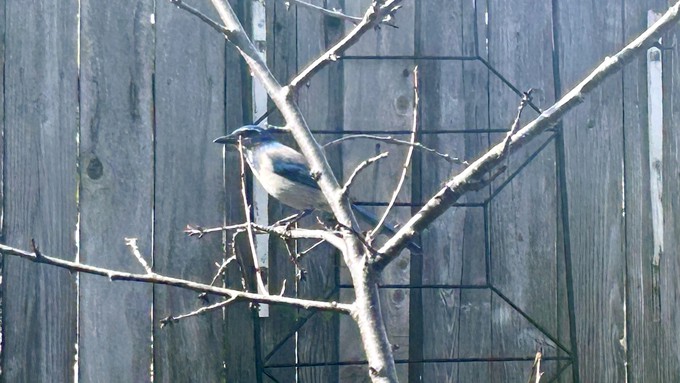
Volunteer birdwatchers of all ages can take part in four-day census

A California scrub jay visits a Carmichael backyard. California last year submitted the most bird lists during the Great Backyard Bird Count, which runs Feb. 16-19 this year. Kathy Morrison
This weekend, grab some binoculars and participate in one of the world’s largest citizen science projects. All it takes is 15 minutes in your own backyard or neighborhood park. And the whole family can get involved.
It’s the Great Backyard Bird Count (GBBC), a four-day snapshot of avian diversity that’s become a worldwide phenomenon. More than 555,000 birders participated in 2023 with expectations of even more this weekend.
Held over the long Presidents’ Day Weekend (Feb. 16 through 19), volunteers of all ages and abilities take part in this census of our feathered friends. Because its emphasis is on backyards and neighborhoods, the count helps build awareness of our suburban wildlife while serving as a measurement of bird diversity since 1998.
To get you started, the organizers are hosting a free webinar via YouTube at 10 a.m. Tuesday, Feb. 13. “Panelists will explain how to participate in this exciting global event and how participation might extend past your back door,” say the hosts. “Discover how to join a group taking part in the GBBC and explore fun ways to involve kids. From bird ID tips to counting birds with ease, this webinar is your ticket to an engaging and confident GBBC experience.”
Sign up for it here: https://www.birdcount.org/
Co-hosted by the Audubon Society and the Cornell Lab of Ornithology, the GBBC is open to birdwatchers anywhere. And it’s free to participate.
The challenge is simple: Count how many birds you see during a 15-minute period (or more) during the four-day event in a specific space, such as your backyard. You also can count birds in a neighborhood park, along a stream or river, or wherever you like. The key: Document what you see including the bird species as well as number.
Handy tools are offered online to help with identification, such as Merlin Bird ID. (It can ID most of your sightings with three easy questions.) Also, take photos to help with that ID process (and to document your observation – experienced bird watchers will review your findings). Then, submit your list of birds to the GBBC using the eBird tool (also available online).
A source of fun and fascination during the COVID lockdown, the bird count has continued to grow.
In 2023, nearly 335,000 checklists were submitted from 202 countries, including 236,904 in the United States. That’s a 34% increase from pre-pandemic 2020.
In the U.S., California submitted the most checklists – 21,585, nearly a 7% increase from 2022.
With more eyes came more diversity of birds. Worldwide, 7,732 bird species – about two-thirds of the planet’s known species – were observed and 7,538 were verified, about 800 more than 2020.
U.S. participants recorded 674 species in 2023. California birders spotted 389 species, the most of any state.
In Sacramento, 660 checklists recorded 170 species, topped by the western screech owl. (Crows, of course, were also very common as well as blackbirds.) Sacramento even had a confirmed bald eagle sighting at the Kiefer landfill.
In the U.S., the birds appearing on the most checklists were distinctive species that are easy to spot (and tend to love bird feeders): Northern cardinal, house finch and dark-eyed junco.
GBBC isn’t limited to home landscapes. Locally, birders reported 70 species along the American River Parkway, one of several local hot spots.
To participate or learn more: https://www.birdcount.org/
Comments
0 comments have been posted.Sacramento Digs Gardening to your inbox.
Sites We Like
Garden Checklist for week of Nov. 3
November still offers good weather for fall planting:
* If you haven't already, it's time to clean up the remains of summer. Pull faded annuals and vegetables. Prune dead or broken branches from trees.
* Now is the best time to plant most trees and shrubs. This gives them plenty of time for root development before spring growth. They also benefit from fall and winter rains.
* Set out cool-weather annuals such as pansies and snapdragons.
* Lettuce, cabbage and broccoli also can be planted now.
* Plant garlic and onions.
* Keep planting bulbs to spread out your spring bloom. Some possible suggestions: daffodils, crocuses, hyacinths, tulips, anemones and scillas.
* This is also a good time to seed wildflowers and plant such spring bloomers as sweet pea, sweet alyssum and bachelor buttons.
* Rake and compost leaves, but dispose of any diseased plant material. For example, if peach and nectarine trees showed signs of leaf curl this year, clean up under trees and dispose of those leaves instead of composting.
* Save dry stalks and seedpods from poppies and coneflowers for fall bouquets and holiday decorating.
* For holiday blooms indoors, plant paperwhite narcissus bulbs now. Fill a shallow bowl or dish with 2 inches of rocks or pebbles. Place bulbs in the dish with the root end nestled in the rocks. Add water until it just touches the bottom of the bulbs. Place the dish in a sunny window. Add water as needed.
* Give your azaleas, gardenias and camellias a boost with chelated iron.
* For larger blooms, pinch off some camellia buds.
* Prune non-flowering trees and shrubs while dormant.
* To help prevent leaf curl, apply a copper fungicide spray to peach and nectarine trees after they lose their leaves this month. Leaf curl, which shows up in the spring, is caused by a fungus that winters as spores on the limbs and around the tree in fallen leaves. Sprays are most effective now.